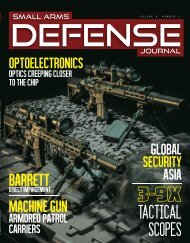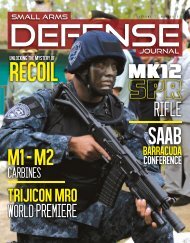SAR 18#6
Create successful ePaper yourself
Turn your PDF publications into a flip-book with our unique Google optimized e-Paper software.
2014 Firearms Directory<br />
OR<br />
TX<br />
WI<br />
WI<br />
AZ<br />
AZ<br />
CLASS 2 MANUFACTURER<br />
CLASS 3 DEALER<br />
dealer from transacting with Alvarez<br />
face-to-face and thwarted application<br />
of the federal firearm’s law requirements.<br />
Alvarez however underwent a<br />
background check with a dealer in his<br />
home state.<br />
Abramski noted that until 1995,<br />
the ATF took the view that a straw purchaser’s<br />
misrepresentation counted<br />
as material only if the true buyer could<br />
not legally possess a gun. The majority<br />
of the court disregarded this point,<br />
noting that only the voice of Congress<br />
mattered and nothing Congress did<br />
has supported Abramski’s view that<br />
straw purchasing for a non-prohibited<br />
person was legal.<br />
The Dissent<br />
In the dissent, Justice Scalia<br />
joined with chief justice Roberts, and<br />
justices Thomas and Alito to note that<br />
under §922(a)(6), it is a crime to make<br />
a “false...statement” to a licensed gun<br />
dealer about a “fact material to the<br />
lawfulness of” a firearms sale. While<br />
Abramski made a false statement<br />
when he claimed to be the gun’s “actual<br />
transferee/buyer” as Form 4473<br />
defined that term, that false statement<br />
was not “material to the lawfulness<br />
of the sale” since the truth – that<br />
Abramski was buying the gun for his<br />
uncle with his uncle’s money – would<br />
not have made the sale unlawful.<br />
The dissenters also wrote that<br />
no provision of the Gun Control Act<br />
prohibits a person who is eligible to<br />
possess firearms from buying a gun<br />
for another person who is eligible to<br />
possess firearms, even at the other’s<br />
request and with the other’s money.<br />
The justices found the government’s<br />
contention that Abramski’s<br />
false statement was material to the<br />
lawfulness of the sale depends on a<br />
strained interpretation of provisions<br />
that mention the “person” to whom a<br />
dealer “sells” a gun. The government<br />
contended that Abramski’s uncle was<br />
the person the dealer sold the gun to<br />
and that Abramski prevented the dealer<br />
from running the background check<br />
on the real buyer, checking his ID,<br />
etc., though this was later done.<br />
The dissenters found that the uncle<br />
was not the person who bought<br />
the gun, but that it was Abramski who<br />
fulfilled all federal requirements albeit<br />
providing a false answer to question<br />
11.a. They note that a vendor sells<br />
an item of merchandise to the person<br />
who physically appears in his<br />
store, selects the item, pays for it, and<br />
takes possession.<br />
The dissenters also rejected the<br />
heart of the majority’s argument in its<br />
claim that unless Abramski’s uncle is<br />
deemed the “person” to whom the gun<br />
was “sold,” and that the Gun Control<br />
Act’s identification, background-check<br />
and recordkeeping requirements<br />
would be “rendered meaningless”<br />
as an overstatement. They opined<br />
that the purpose of crime prevention<br />
might be served more effectively if<br />
the requirements at issue looked past<br />
the “man at the counter” to the person<br />
“getting the gun,” to ensure he is<br />
eligible to possess firearms.<br />
The dissenting justices also listed<br />
<strong>SAR</strong> Vol. 18, No. 6 104 Nov., Dec. 2014









